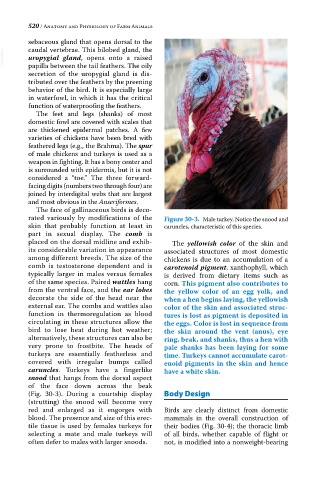Page 535 - Anatomy and Physiology of Farm Animals, 8th Edition
P. 535
520 / Anatomy and Physiology of Farm Animals
sebaceous gland that opens dorsal to the
caudal vertebrae. This bilobed gland, the
VetBooks.ir uropygial gland, opens onto a raised
papilla between the tail feathers. The oily
secretion of the uropygial gland is dis-
tributed over the feathers by the preening
behavior of the bird. It is especially large
in waterfowl, in which it has the critical
function of waterproofing the feathers.
The feet and legs (shanks) of most
domestic fowl are covered with scales that
are thickened epidermal patches. A few
varieties of chickens have been bred with
feathered legs (e.g., the Brahma). The spur
of male chickens and turkeys is used as a
weapon in fighting. It has a bony center and
is surrounded with epidermis, but it is not
considered a “toe.” The three forward‐
facing digits (numbers two through four) are
joined by interdigital webs that are largest
and most obvious in the Anseriformes.
The face of gallinaceous birds is deco-
rated variously by modifications of the Figure 30-3. Male turkey. Notice the snood and
skin that probably function at least in caruncles, characteristic of this species.
part in sexual display. The comb is
placed on the dorsal midline and exhib- The yellowish color of the skin and
its considerable variation in appearance associated structures of most domestic
among different breeds. The size of the chickens is due to an accumulation of a
comb is testosterone dependent and is carotenoid pigment, xanthophyll, which
typically larger in males versus females is derived from dietary items such as
of the same species. Paired wattles hang corn. This pigment also contributes to
from the ventral face, and the ear lobes the yellow color of an egg yolk, and
decorate the side of the head near the when a hen begins laying, the yellowish
external ear. The combs and wattles also color of the skin and associated struc-
function in thermoregulation as blood tures is lost as pigment is deposited in
circulating in these structures allow the the eggs. Color is lost in sequence from
bird to lose heat during hot weather; the skin around the vent (anus), eye
alternatively, these structures can also be ring, beak, and shanks, thus a hen with
very prone to frostbite. The heads of pale shanks has been laying for some
turkeys are essentially featherless and time. Turkeys cannot accumulate carot-
covered with irregular bumps called enoid pigments in the skin and hence
caruncles. Turkeys have a fingerlike have a white skin.
snood that hangs from the dorsal aspect
of the face down across the beak
(Fig. 30‐3). During a courtship display Body Design
(strutting) the snood will become very
red and enlarged as it engorges with Birds are clearly distinct from domestic
blood. The presence and size of this erec- mammals in the overall construction of
tile tissue is used by females turkeys for their bodies (Fig. 30‐4); the thoracic limb
selecting a mate and male turkeys will of all birds, whether capable of flight or
often defer to males with larger snoods. not, is modified into a nonweight‐bearing

